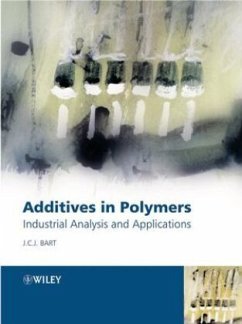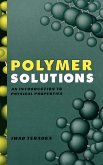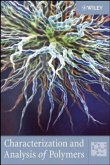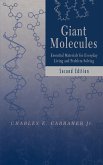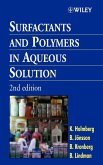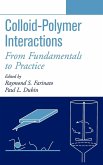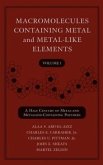- Gebundenes Buch
- Merkliste
- Auf die Merkliste
- Bewerten Bewerten
- Teilen
- Produkt teilen
- Produkterinnerung
- Produkterinnerung
This industrially relevant resource covers all established and emerging analytical methods for the deformulation of polymeric materials, with emphasis on the non-polymeric components. _ Each technique is evaluated on its technical and industrial merits. _ Emphasis is on understanding (principles and characteristics) and industrial applicability. _ Extensively illustrated throughout with over 200 figures, 400 tables, and 3,000 references.
Andere Kunden interessierten sich auch für
![Polymer Solutions Polymer Solutions]() Iwao TeraokaPolymer Solutions170,99 €
Iwao TeraokaPolymer Solutions170,99 €![Polymers Inside Out Polymers Inside Out]() Alan E. TonelliPolymers Inside Out149,99 €
Alan E. TonelliPolymers Inside Out149,99 €![Characterization and Analysis of Polymers Characterization and Analysis of Polymers]() WileyCharacterization and Analysis of Polymers406,99 €
WileyCharacterization and Analysis of Polymers406,99 €![Giant Molecules Giant Molecules]() Carraher, Charles E., Jr.Giant Molecules192,99 €
Carraher, Charles E., Jr.Giant Molecules192,99 €![Surfactants and Polymers in Aqueous Solution Surfactants and Polymers in Aqueous Solution]() Krister HolmbergSurfactants and Polymers in Aqueous Solution177,99 €
Krister HolmbergSurfactants and Polymers in Aqueous Solution177,99 €![Colloid-Polymer Interactions Colloid-Polymer Interactions]() Raymond S. Farinato / Paul L. Dubin (Hgg.)Colloid-Polymer Interactions228,99 €
Raymond S. Farinato / Paul L. Dubin (Hgg.)Colloid-Polymer Interactions228,99 €![Macromolecules Containing Metal and Metal-Like Elements, Volume 1 Macromolecules Containing Metal and Metal-Like Elements, Volume 1]() Charles U. PittmanMacromolecules Containing Metal and Metal-Like Elements, Volume 1249,99 €
Charles U. PittmanMacromolecules Containing Metal and Metal-Like Elements, Volume 1249,99 €-
-
-
This industrially relevant resource covers all established and emerging analytical methods for the deformulation of polymeric materials, with emphasis on the non-polymeric components.
_ Each technique is evaluated on its technical and industrial merits.
_ Emphasis is on understanding (principles and characteristics) and industrial applicability.
_ Extensively illustrated throughout with over 200 figures, 400 tables, and 3,000 references.
Hinweis: Dieser Artikel kann nur an eine deutsche Lieferadresse ausgeliefert werden.
_ Each technique is evaluated on its technical and industrial merits.
_ Emphasis is on understanding (principles and characteristics) and industrial applicability.
_ Extensively illustrated throughout with over 200 figures, 400 tables, and 3,000 references.
Hinweis: Dieser Artikel kann nur an eine deutsche Lieferadresse ausgeliefert werden.
Produktdetails
- Produktdetails
- Verlag: Wiley & Sons
- 1. Auflage
- Seitenzahl: 840
- Erscheinungstermin: 4. Februar 2005
- Englisch
- Abmessung: 246mm x 189mm x 45mm
- Gewicht: 1930g
- ISBN-13: 9780470850626
- ISBN-10: 0470850620
- Artikelnr.: 13337991
- Herstellerkennzeichnung Die Herstellerinformationen sind derzeit nicht verfügbar.
- Verlag: Wiley & Sons
- 1. Auflage
- Seitenzahl: 840
- Erscheinungstermin: 4. Februar 2005
- Englisch
- Abmessung: 246mm x 189mm x 45mm
- Gewicht: 1930g
- ISBN-13: 9780470850626
- ISBN-10: 0470850620
- Artikelnr.: 13337991
- Herstellerkennzeichnung Die Herstellerinformationen sind derzeit nicht verfügbar.
J. Bart, DSM Research, The Netherlands
Jan C. J. Bart (Ph.D. Structural Chemistry, University of Amsterdam) is a senior scientist with a broad interest in materials characterization, heterogeneous catalysis and product development who has spent an industrial career in R&D with Monsanto, Montedison and DSM Research in various countries. The author has held several teaching assignments and researched extensively in both academic and industrial areas; he has authored over 250 scientific papers, including chapters in books. He has acted as Ramsay Memorial Fellow at the Universities of Leeds (Colour Chemistry) and Oxford (Material Sciences), a visiting scientist at the Institut de Recherches sur la Catalyse (CNRS, Villeurbanne) and a Meyerhoff Visiting Professor at WIS (Rehovot) and held an Invited Professorship at USTC (Hefei). He is currently a Full Professor of Industrial Chemistry at the University of Messina.
Jan C. J. Bart (Ph.D. Structural Chemistry, University of Amsterdam) is a senior scientist with a broad interest in materials characterization, heterogeneous catalysis and product development who has spent an industrial career in R&D with Monsanto, Montedison and DSM Research in various countries. The author has held several teaching assignments and researched extensively in both academic and industrial areas; he has authored over 250 scientific papers, including chapters in books. He has acted as Ramsay Memorial Fellow at the Universities of Leeds (Colour Chemistry) and Oxford (Material Sciences), a visiting scientist at the Institut de Recherches sur la Catalyse (CNRS, Villeurbanne) and a Meyerhoff Visiting Professor at WIS (Rehovot) and held an Invited Professorship at USTC (Hefei). He is currently a Full Professor of Industrial Chemistry at the University of Messina.
- Foreword.
- Preface.
- About the Author.
- Acknowledgements.
- Chapter 1: Introduction.
1.1 Additives.
1.2 Plastics formulations .
1.3 Economic impact of polymer additives.
1.4 Analysis of plastics.
1.5 Bibliography.
1.6 References.
- Chapter 2: Deformulation Principles.
2.1 Polymer identification.
2.2 Additive analysis of rubbers: 'Best Practice'.
2.3 Polymer extract analysis.
2.4 In situ polymer/additive analysis.
2.5 Class-specific polymer/additive analysis.
2.6 Bibliography.
2.7 References.
- Chapter 3: Sample Preparation Perspectives.
3.1 Solvents.
3.2 Extraction strategy.
3.3 Conventional extraction technologies.
3.4 High-pressure solvent extraction methods.
3.5 Sorbent extraction.
3.6 Methodological comparison of extraction methods.
3.7 Polymer/additive dissolution methods.
3.8 Hydrolysis.
3.9 Bibliography.
3.10 References.
- Chapter 4: Separation Techniques.
4.1 Analytical detectors.
4.2 Gas chromatography.
4.3 Supercritical fluid chromatography.
4.4 Liquid chromatography techniques.
4.5 Capillary electrophoretic techniques.
4.6 Bibliography.
4.7 References.
- Chapter 5: Polymer/Additive Analysis: The Spectroscopic Alternative.
5.1 Ultraviolet/visible spectrophotometry.
5.2 Infrared spectroscopy.
5.3 Luminescence spectroscopy.8
5.4 High-resolution nuclear magnetic resonance spectroscopy.
5.5 Bibliography.
5.6 References.
- Chapter 6: Organic Mass-Spectrometric Methods.
6.1 Basic instrumentation.
6.2 Ion sources.
6.3 Mass analysers.
6.4 Direct mass-spectrometric polymer compound analysis.
6.5 Ion mobility spectrometry.
6.6 Bibliography.
6.7 References.
- Chapter 7: Multihyphenation and Multidimensionality in Polymer/Additive Analysis.
7.1 Precolumn hyphenation.
7.2 Coupled sample preparation - spectroscopy/spectrometry.
7.3 Postcolumn hyphenation.
7.4 Multidimensional chromatography.
7.5 Multidimensional spectroscopy.
7.6 Bibliography.
7.7 References.
- Chapter 8: Inorganic and Element Analytical Methods.
8.1 Element analytical protocols.
8.2 Sample destruction for classical elemental analysis.
8.3 Analytical atomic spectrometry.
8.4 X-ray spectrometry.
8.5 Inorganic mass spectrometry.
8.6 Radioanalytical and nuclear analytical methods.
8.7 Electroanalytical techniques.
8.8 Solid-state speciation analysis.
8.9 Bibliography.
8.10 References.
- Chapter 9: Direct Methods of Deformulation of Polymer/Additive Dissolutions.
9.1 Chromatographic methods.
9.2 Spectroscopic techniques.
9.3 Mass-spectrometric methods.
9.4 References.
- Chapter 10: A Vision for the Future.
10.1 Trends in polymer technology.
10.2 Trends in additive technology.
10.3 Environmental, legislative and regulatory constraints.
10.4 Analytical consequences.
10.5 Epilogue.
10.6 Bibliography.
10.7 References.
- Appendix I: List of Symbols.
- Appendix II: Functionality of Common Additives Used in Commercial Thermoplastics, Rubbers and Thermosetting Resins.
- Appendix III: Specimen Polymer Additives Product Sheets.
- Index.
- Preface.
- About the Author.
- Acknowledgements.
- Chapter 1: Introduction.
1.1 Additives.
1.2 Plastics formulations .
1.3 Economic impact of polymer additives.
1.4 Analysis of plastics.
1.5 Bibliography.
1.6 References.
- Chapter 2: Deformulation Principles.
2.1 Polymer identification.
2.2 Additive analysis of rubbers: 'Best Practice'.
2.3 Polymer extract analysis.
2.4 In situ polymer/additive analysis.
2.5 Class-specific polymer/additive analysis.
2.6 Bibliography.
2.7 References.
- Chapter 3: Sample Preparation Perspectives.
3.1 Solvents.
3.2 Extraction strategy.
3.3 Conventional extraction technologies.
3.4 High-pressure solvent extraction methods.
3.5 Sorbent extraction.
3.6 Methodological comparison of extraction methods.
3.7 Polymer/additive dissolution methods.
3.8 Hydrolysis.
3.9 Bibliography.
3.10 References.
- Chapter 4: Separation Techniques.
4.1 Analytical detectors.
4.2 Gas chromatography.
4.3 Supercritical fluid chromatography.
4.4 Liquid chromatography techniques.
4.5 Capillary electrophoretic techniques.
4.6 Bibliography.
4.7 References.
- Chapter 5: Polymer/Additive Analysis: The Spectroscopic Alternative.
5.1 Ultraviolet/visible spectrophotometry.
5.2 Infrared spectroscopy.
5.3 Luminescence spectroscopy.8
5.4 High-resolution nuclear magnetic resonance spectroscopy.
5.5 Bibliography.
5.6 References.
- Chapter 6: Organic Mass-Spectrometric Methods.
6.1 Basic instrumentation.
6.2 Ion sources.
6.3 Mass analysers.
6.4 Direct mass-spectrometric polymer compound analysis.
6.5 Ion mobility spectrometry.
6.6 Bibliography.
6.7 References.
- Chapter 7: Multihyphenation and Multidimensionality in Polymer/Additive Analysis.
7.1 Precolumn hyphenation.
7.2 Coupled sample preparation - spectroscopy/spectrometry.
7.3 Postcolumn hyphenation.
7.4 Multidimensional chromatography.
7.5 Multidimensional spectroscopy.
7.6 Bibliography.
7.7 References.
- Chapter 8: Inorganic and Element Analytical Methods.
8.1 Element analytical protocols.
8.2 Sample destruction for classical elemental analysis.
8.3 Analytical atomic spectrometry.
8.4 X-ray spectrometry.
8.5 Inorganic mass spectrometry.
8.6 Radioanalytical and nuclear analytical methods.
8.7 Electroanalytical techniques.
8.8 Solid-state speciation analysis.
8.9 Bibliography.
8.10 References.
- Chapter 9: Direct Methods of Deformulation of Polymer/Additive Dissolutions.
9.1 Chromatographic methods.
9.2 Spectroscopic techniques.
9.3 Mass-spectrometric methods.
9.4 References.
- Chapter 10: A Vision for the Future.
10.1 Trends in polymer technology.
10.2 Trends in additive technology.
10.3 Environmental, legislative and regulatory constraints.
10.4 Analytical consequences.
10.5 Epilogue.
10.6 Bibliography.
10.7 References.
- Appendix I: List of Symbols.
- Appendix II: Functionality of Common Additives Used in Commercial Thermoplastics, Rubbers and Thermosetting Resins.
- Appendix III: Specimen Polymer Additives Product Sheets.
- Index.
- Foreword.
- Preface.
- About the Author.
- Acknowledgements.
- Chapter 1: Introduction.
1.1 Additives.
1.2 Plastics formulations .
1.3 Economic impact of polymer additives.
1.4 Analysis of plastics.
1.5 Bibliography.
1.6 References.
- Chapter 2: Deformulation Principles.
2.1 Polymer identification.
2.2 Additive analysis of rubbers: 'Best Practice'.
2.3 Polymer extract analysis.
2.4 In situ polymer/additive analysis.
2.5 Class-specific polymer/additive analysis.
2.6 Bibliography.
2.7 References.
- Chapter 3: Sample Preparation Perspectives.
3.1 Solvents.
3.2 Extraction strategy.
3.3 Conventional extraction technologies.
3.4 High-pressure solvent extraction methods.
3.5 Sorbent extraction.
3.6 Methodological comparison of extraction methods.
3.7 Polymer/additive dissolution methods.
3.8 Hydrolysis.
3.9 Bibliography.
3.10 References.
- Chapter 4: Separation Techniques.
4.1 Analytical detectors.
4.2 Gas chromatography.
4.3 Supercritical fluid chromatography.
4.4 Liquid chromatography techniques.
4.5 Capillary electrophoretic techniques.
4.6 Bibliography.
4.7 References.
- Chapter 5: Polymer/Additive Analysis: The Spectroscopic Alternative.
5.1 Ultraviolet/visible spectrophotometry.
5.2 Infrared spectroscopy.
5.3 Luminescence spectroscopy.8
5.4 High-resolution nuclear magnetic resonance spectroscopy.
5.5 Bibliography.
5.6 References.
- Chapter 6: Organic Mass-Spectrometric Methods.
6.1 Basic instrumentation.
6.2 Ion sources.
6.3 Mass analysers.
6.4 Direct mass-spectrometric polymer compound analysis.
6.5 Ion mobility spectrometry.
6.6 Bibliography.
6.7 References.
- Chapter 7: Multihyphenation and Multidimensionality in Polymer/Additive Analysis.
7.1 Precolumn hyphenation.
7.2 Coupled sample preparation - spectroscopy/spectrometry.
7.3 Postcolumn hyphenation.
7.4 Multidimensional chromatography.
7.5 Multidimensional spectroscopy.
7.6 Bibliography.
7.7 References.
- Chapter 8: Inorganic and Element Analytical Methods.
8.1 Element analytical protocols.
8.2 Sample destruction for classical elemental analysis.
8.3 Analytical atomic spectrometry.
8.4 X-ray spectrometry.
8.5 Inorganic mass spectrometry.
8.6 Radioanalytical and nuclear analytical methods.
8.7 Electroanalytical techniques.
8.8 Solid-state speciation analysis.
8.9 Bibliography.
8.10 References.
- Chapter 9: Direct Methods of Deformulation of Polymer/Additive Dissolutions.
9.1 Chromatographic methods.
9.2 Spectroscopic techniques.
9.3 Mass-spectrometric methods.
9.4 References.
- Chapter 10: A Vision for the Future.
10.1 Trends in polymer technology.
10.2 Trends in additive technology.
10.3 Environmental, legislative and regulatory constraints.
10.4 Analytical consequences.
10.5 Epilogue.
10.6 Bibliography.
10.7 References.
- Appendix I: List of Symbols.
- Appendix II: Functionality of Common Additives Used in Commercial Thermoplastics, Rubbers and Thermosetting Resins.
- Appendix III: Specimen Polymer Additives Product Sheets.
- Index.
- Preface.
- About the Author.
- Acknowledgements.
- Chapter 1: Introduction.
1.1 Additives.
1.2 Plastics formulations .
1.3 Economic impact of polymer additives.
1.4 Analysis of plastics.
1.5 Bibliography.
1.6 References.
- Chapter 2: Deformulation Principles.
2.1 Polymer identification.
2.2 Additive analysis of rubbers: 'Best Practice'.
2.3 Polymer extract analysis.
2.4 In situ polymer/additive analysis.
2.5 Class-specific polymer/additive analysis.
2.6 Bibliography.
2.7 References.
- Chapter 3: Sample Preparation Perspectives.
3.1 Solvents.
3.2 Extraction strategy.
3.3 Conventional extraction technologies.
3.4 High-pressure solvent extraction methods.
3.5 Sorbent extraction.
3.6 Methodological comparison of extraction methods.
3.7 Polymer/additive dissolution methods.
3.8 Hydrolysis.
3.9 Bibliography.
3.10 References.
- Chapter 4: Separation Techniques.
4.1 Analytical detectors.
4.2 Gas chromatography.
4.3 Supercritical fluid chromatography.
4.4 Liquid chromatography techniques.
4.5 Capillary electrophoretic techniques.
4.6 Bibliography.
4.7 References.
- Chapter 5: Polymer/Additive Analysis: The Spectroscopic Alternative.
5.1 Ultraviolet/visible spectrophotometry.
5.2 Infrared spectroscopy.
5.3 Luminescence spectroscopy.8
5.4 High-resolution nuclear magnetic resonance spectroscopy.
5.5 Bibliography.
5.6 References.
- Chapter 6: Organic Mass-Spectrometric Methods.
6.1 Basic instrumentation.
6.2 Ion sources.
6.3 Mass analysers.
6.4 Direct mass-spectrometric polymer compound analysis.
6.5 Ion mobility spectrometry.
6.6 Bibliography.
6.7 References.
- Chapter 7: Multihyphenation and Multidimensionality in Polymer/Additive Analysis.
7.1 Precolumn hyphenation.
7.2 Coupled sample preparation - spectroscopy/spectrometry.
7.3 Postcolumn hyphenation.
7.4 Multidimensional chromatography.
7.5 Multidimensional spectroscopy.
7.6 Bibliography.
7.7 References.
- Chapter 8: Inorganic and Element Analytical Methods.
8.1 Element analytical protocols.
8.2 Sample destruction for classical elemental analysis.
8.3 Analytical atomic spectrometry.
8.4 X-ray spectrometry.
8.5 Inorganic mass spectrometry.
8.6 Radioanalytical and nuclear analytical methods.
8.7 Electroanalytical techniques.
8.8 Solid-state speciation analysis.
8.9 Bibliography.
8.10 References.
- Chapter 9: Direct Methods of Deformulation of Polymer/Additive Dissolutions.
9.1 Chromatographic methods.
9.2 Spectroscopic techniques.
9.3 Mass-spectrometric methods.
9.4 References.
- Chapter 10: A Vision for the Future.
10.1 Trends in polymer technology.
10.2 Trends in additive technology.
10.3 Environmental, legislative and regulatory constraints.
10.4 Analytical consequences.
10.5 Epilogue.
10.6 Bibliography.
10.7 References.
- Appendix I: List of Symbols.
- Appendix II: Functionality of Common Additives Used in Commercial Thermoplastics, Rubbers and Thermosetting Resins.
- Appendix III: Specimen Polymer Additives Product Sheets.
- Index.

